ART TALK MAGAZINE-SWITZERLAND
Peggy Kliafa
Pharmakon
by Carolina Conforti
Read the interview here
I met Peggy Kliafa during Art Athina 2020 on my extraordinary art “tour de force “in September. It was a Sunday morning, just before heading off to Zurich.
I can still feel the energy, the dynamic positivism of my beloved Athens. Peggy Kliafa introduced me to an expected philosophical modus vivendi which changed my all concept of seeing medicine packages! Peggy ‘s works of art are often compared to Damien Hirst’s “pharmacy seduction”. Her “Pharmakon”- Medicine is a tribute to the Medicine science throughout History until nowadays. Her works of Art made by pharmaceutical packaging and capsules, are witness of the ephemerality of human existence: our attitude towards life and death, the power of faith, innocence, trust, nature duality and moderation. Peggy narrates in her humble and warm smile throughout her sparkling creations, how humans perceive this knowledge of finding a miracle cure to the incurable, as well as the resulting improvement of the human condition. It is fascinating to perceive a mere capsule as a philosophical thread to our inner fears and hopes.
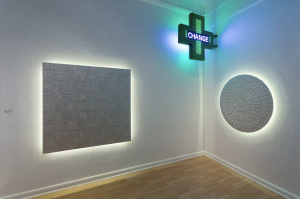
Peggy Kliafa, Armory Series and Pharmacy Cross Change
Dear Peggy, what inspired you to dedicate your life in creating such extraordinary works of art? What fascinates you the most: the medicines’ colors, the shapes, or the textures?
My work alludes to Medicines, treatment and healing of body and soul. But it took quite some time to creatively express my interest in medicines. I have graduated from the Athens School of Fine Arts (integrated Masters’ Degree) in the Department of Painting with major in Sculpture in 2011/2012. Before that, I had studied Business Administration and had worked in this field for some time. Coming across a pills’ advertisement in a magazine -while still studying – was a pivotal moment that brought out dilemmas that had always been on my mind: should I take another pill? Should my children be given antibiotics again? Should medicines be advertised? etc. The power of medicines looked like a big as well as a controversial issue.
Apart from their obvious and hidden meanings, medicines are also aesthetically interesting. In my eyes, their colours, shapes and textures are a source of inspiration too. Medicines have a rich history but they also have a corporeality, polychromy, abundance of shapes and sizes. Their packaging is equally inspiring for me. I use medicines in the same way that another artist would use pigments, clay or any other traditional artistic medium. In my mosaics, pills become tiles and add colour, in my chandeliers, capsules become small transparent crystals, in my stained-glass panels, blisters transform into perforated glasses penetrated by a mystic light and in my abstract metal artworks, textured elements play with light and shadows. It’s a fascinating world full of possibilities!
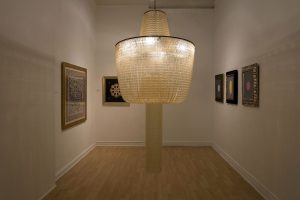
Solo exhibition “Placebo”, Lola Nikolaou Gallery, Thessaloniki, Greece. Chandelier II, Mosaic “Omphalio”, Mosaic “Lace”, 3 Pills’ Portraits
Your artistic voyage is incredible! Which exhibition has stayed in your “heArt”?
Both of my solo exhibitions have a special place in my heart: the first one entitled “PHARMAKON” took place in Kappatos Gallery, Athens in 2013 and the second one “PLACEBO” was held in Lola Nikolaou Gallery, Thessaloniki in 2016.
“PHARMAKON” was divided into three sections, “Religion-Metaphysics”, “Nature”, and “Science –Chemistry”, reflecting my personal scientific and historical research on the treatment of human disease, from metaphysics and religion to the development of science and chemistry. The exhibition illustrated the history of healing as a palimpsest of metaphysics, nature and science. I feel like it was a powerful artistic proposition that initiated me into the world of solo exhibitions.
In “PLACEBO”, I mostly focused on the foundations of the Western perception of natural and scientific miracles, as well as intellectual ones. The fact that the materials used referred to the power of science to heal through medication, whereas the exhibition title implied the possibility of self-delusion certainly provided some food for thought and discussion.
I am really grateful for these two exhibitions and looking forward to my next solo exhibition on which I am currently working on.
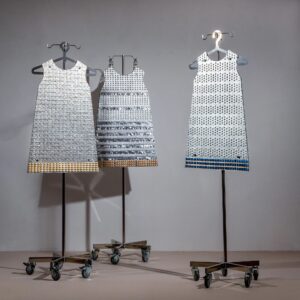
Peggy Kliafa, Dance, 3 Armour-Dresses on IV Poles
You describe that Medicines, Love, Religion are all connected, and “everything is potentially a cure or a poison.”
Love as “Love is a smoke raised with the fume of sighs; Being purged, a fire sparkling in lovers’ eyes; Being vex’d a sea nourish’d with lovers’ tears.”
– Romeo (Act I, Scene).
Why? And is there a thread that unifies our fears and hopes?
Conceptually what attracts me to medicines is their “miraculous” power, their dual nature “which acts as both remedy and poison” as Jacques Derrida mentions in his book “PLATO’S PHARMACY – DISSEMINATION”. The relationship between healing, medicines and religion, in the physical and metaphysical sense, transcends time and space. With social evolution over the years, they started to be differentiated, although even today we resort to both in times of despair. They both preserve a sense of magic, as love does.
Medication, love, religion are neither good nor bad by themselves. What makes them one or the other is the way they are used and expressed. The medicine itself has done a lot of good to human life, changing it for the better. Earth’s population would be much smaller, were it not for the discovery of antibiotics. On the other hand, excessive use can lead to the other extreme, that is, for the human body to be incapable of a fight. If there is abuse purely for psychological reasons, that’s bad. Yet, there are people who wake up every morning and go to work thanks to drugs. It is a refuge, just like religion.
Our approach to medicines, religion and love is what makes them good or bad, as is the case with most things in life. It is common knowledge that what nourishes us, destroys us. In that sense, our fears and hopes go hand in hand. It certainly is a vicious circle in real life as well as in art.
Our last few years were surreal: a science fiction movie that unfortunately was not a movie … did Covid-19 magnified the power of deifying medication?
It is said that “real life often surpasses the most vivid imagination” and Covid – 19 has been certainly the case. Movies are often based on real events. Over the last couple of years, we have lived such a moment due to the coronavirus pandemic, where the humanity was praying for the science to discover The Vaccine, which would give us a way out of that incredible situation. And here it is. Is it good enough? Is it The answer to our prayers? Truth is in the eye of the beholder.
The pandemic intensified my previous thoughts and proved that the concept behind several artworks of mine was true. I could mention for example the installation I had presented in July 2017 in EMST (National Museum of Contemporary Art) during Documenta 14, entitled “Breathing Booth & The Cost of Breathing”. It was a utopic proposition to install Breathing Booths in the cities’ centers in order to provide free oxygen and “sell” inhalers and masks from a vending machine/sculpture.
Although the importance of microorganisms existed already in my work, for example in the “Bacteria” Series, I had not imagined that the world of the microscope could invade and disorganize the “big” real world into such an extent and gravity.
We most certainly are at a pivotal moment in history because of the pandemic. Unfortunately, extreme situations require extreme measures which lead to extreme reactions. Amidst the current maelstrom, we face a double problem: the deification as well as the disapproval of medicines.
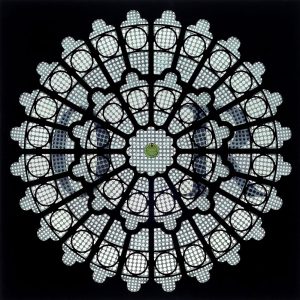
Peggy Kliafa, Vitraux I, Rose Window
Your earlier installations “Imagined Homes”, four religious stained-glass windows, presented in the 6th Biennale of Contemporary Art in Thessaloniki, highlighted this powerful moment in history! How these empty pills’ blisters represent more than ever our human fragility? What has changed in your artistic life since Covid-19?
Based on the Biennale’s concept, Imagined Homes, I presented an installation consisting of a four-sided stained-glass panel which forms an imaginary cube with light in the middle. The light causes the stained-glass patterns to be reflected on the walls around it, creating an imaginative ambiance and evoking a shape potentially reminiscent of a home. My proposal dealt with religion, which can provide a refuge for people in need of stability and inner strength to face life problems.
Here is an excerpt from the Biennale’s catalogue:
“…used packages are transformed into impressive, elaborate compositions, thanks to the decisive intervention of artificial, pure and warm light, which passes through their transparent texture. The compositions define holy, transcendental spaces, where one can be isolated, connect to the remotest sides of oneself, and communicate with the divine…“.
Since we are in the middle of a health, economic and social crisis, I feel the need to assimilate and absorb these new experiences. What I know for sure is that I will approach works and projects with even more respect and appreciation for the universal importance of science, taking into account the fragility of human existence.
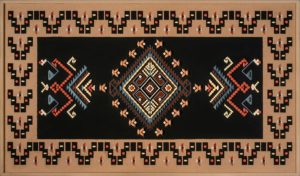
Peggy Kliafa, Pillow I, Mosaic with real pills
All your works are meticulously and “quasi” surgically designed; one more engaging than the other, your “Chandelier” is one of the most fascinating creations … what does it represent? What is the story behind it? How long did it take to complete it?
At first glance, Chandelier appears to be an exquisite crystal light fixture, but it is actually created from empty gelatin pill-capsules. It’s an homage to light, transparency, energy and healing. It therefore encapsulates the properties of a pharmaceutical drug, translating light into energy. At the same time, capsules acquire an aesthetic value that alters completely their original use and connotation.
Light has always been an important element of my work, while my fascination for chandeliers has been going on for a long time. My research on the Placebo Effect brought them together in the context of my work. Light in combination with empty medication packs or empty capsules reminded me of the well-known placebo effect, when an improvement of symptoms is observed, despite using a non-active treatment.
It took a few months to complete it, because the process involved several steps and not all of them depended on me. I started with the design and then I co-operated with a chandelier manufacturer who prepared for me the “framework” of the chandelier under my supervision. Then I had to find and order thousands of gelatin transparent capsules – the main material of these artworks – and make sure of their endurance. Last, very important and extremely time consuming step was the process of penetrating with fish line the capsules and then mounting them on the chandelier. Thousands of capsules, a lot of hours but the result was worth the effort!!!
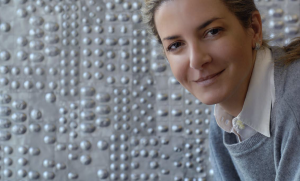
Peggy Kliafa
If you have ever wondered what to do with your medicine packaging – besides bringing them back to recycling or a pharmacy, Peggy Kliafa will reinvent your simple human daily life! She will open a new, fresh and passionate perspective into the fascinating world of Medicine. Your empty box of pills is not a mere package but a philosophical thread to our inner fears and hopes …